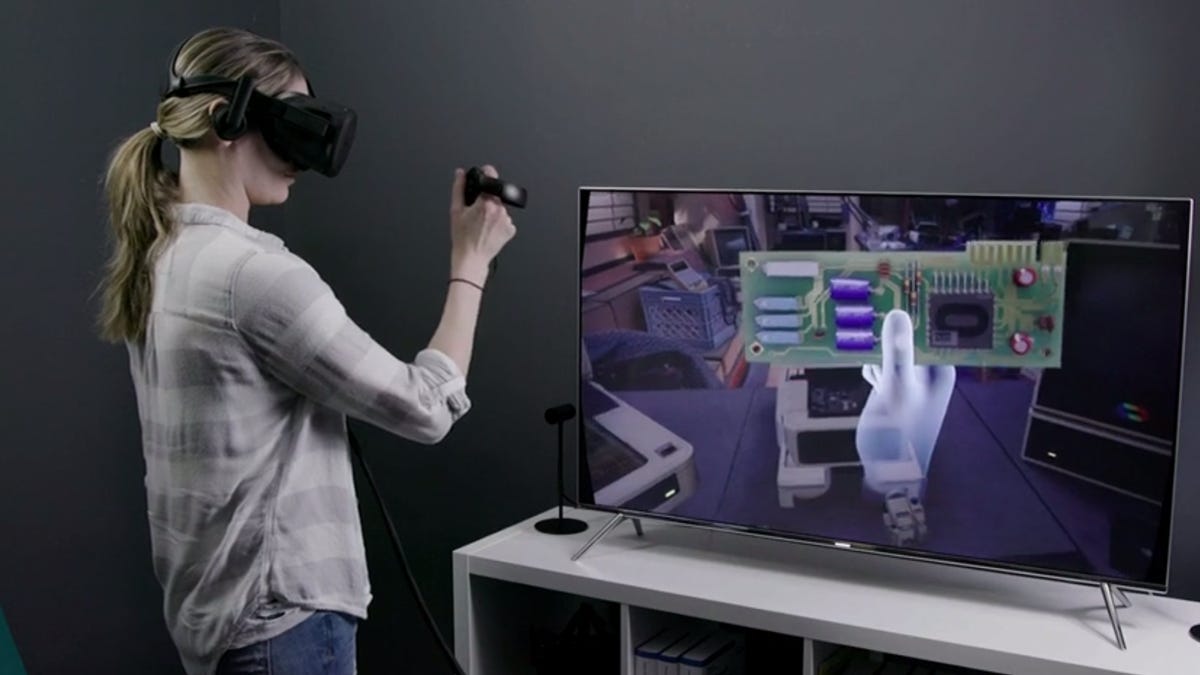A day after Oculus Go debut, Facebook demos next-gen VR plans
A prototype headset known as Half Dome takes on some of VR's big annoyances, like tunnel vision and difficulty focusing on stuff right in front of your face.

Facebook's Oculus Core Tech team unveils a prototype VR headset at F8.
Facebook's new mobile standalone VR headset, Oculus Go, is here. But the future involves more advanced hardware with displays that make VR look a lot better. On Wednesday, Facebook teased us with one such future device.
A virtual-reality prototype headset, referred to internally at Facebook as Half Dome, could advance VR technology past some of its key frustrations, like tunnel-vision field of view and not being able to read something you hold right in front of your (virtual) face.
Facebook's Maria Fernandez Guajardo, who is head of Core Tech product managment at Oculus, introduced Half Dome, which looks a little like an Oculus Rift with miniaturized Frankenstein's monster bolts all over it, and other VR advancements in a presentation at F8, Facebook's developer conference and opportunity to announce major initiatives.
The mechanical moving display inside the new Oculus VR prototype actually moves closer and further away.
Beyond Santa Cruz
Oculus already has plans for a VR headset successor to the Oculus Go: It's called Project Santa Cruz, and it's a mobile standalone headset with full-room tracking and dual controllers that feel like the PC-based Oculus Touch. CNET has tried Santa Cruz, and its motion controls work really well. Santa Cruz is already in developer hands, with Oculus promising more news "by end of year."
But Half Dome, which we haven't tried, is a whole step beyond that, tackling some other specific issues in display tech: field of view and depth of focus. Oculus has a three-part goal to make VR displays higher resolution, have a better field of view and focus on objects like our eyes do in real life. The higher-res display part is something Oculus thinks will happen as displays improve, but the field of view and depth of field needed new hardware ideas.
The headset widens field of view so that users see more in their peripheral vision, moving beyond the range of most existing VR and AR headsets (Starbreeze's StarVR does have an even larger 210-degree field of view, spread over a V-shaped display). Half Dome's variable focus will work along with built-in eye tracking to create a greater sense of depth in virtual 3D objects, both far and near.
Depth of field will allow things to be out of focus (or in focus).
Flexible focus
The varifocal screen is even more fascinating: It has actual mechanically moving parts inside that shift the screen closer and further away to create a sense of focal distance. If you're handed a note in virtual reality, you can actually read it when you hold it up in front of you. Light field-based displays such as Magic Leap's are working on allowing depth of field, too. We tried a light-field-based tech demo on Avengant's AR headset prototype last year. Oculus' hardware approach seems different, but pursuing a similar end.
Facebook's also working on motion-capture tools to improve the fidelity of your hand and finger movements. Much of that seems to involve improved AI that will work off of motion-captured hand models. One video clip of free-form hand movements in VR was similar to what Leap Motion can do with VR headsets currently, but Oculus wants to improve the movement and accuracy of complex manipulation of objects.
This year, F8 takes on added significance, coming as Facebook grapples with scandals on multiple fronts. Facebook faces questions over its privacy track record and its general trustworthiness to steward of one of the most powerful platforms for information and digital relationships on the planet. Zuckerberg has pledged he would "fix" Facebook's biggest problems this year.
Facebook's F8 Developer Conference: Follow CNET's coverage.
Cambridge Analytica: Everything you need to know about Facebook's data mining scandal.



